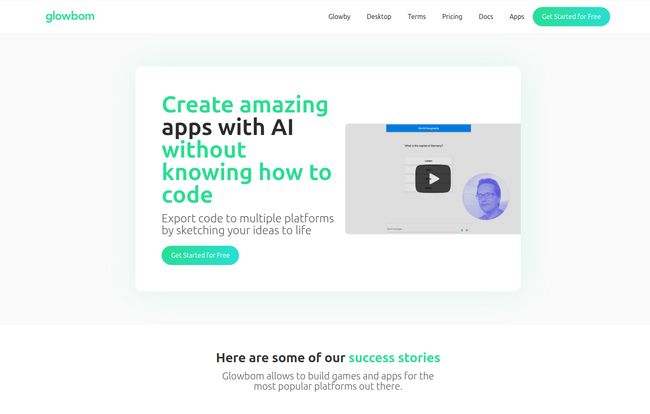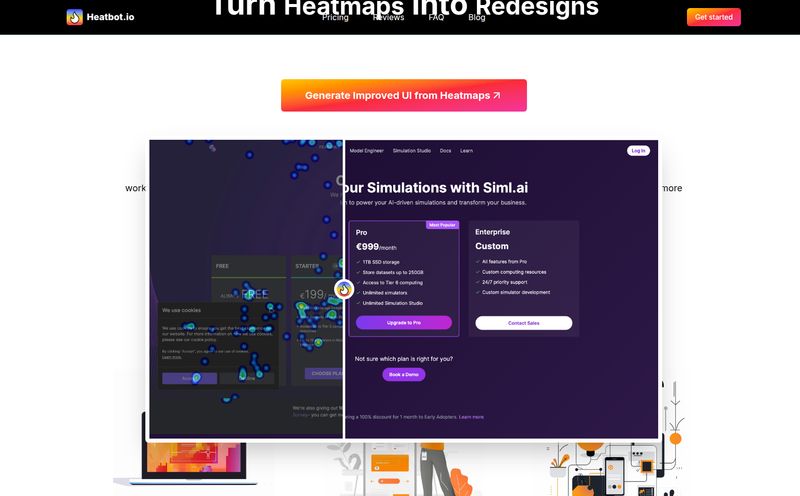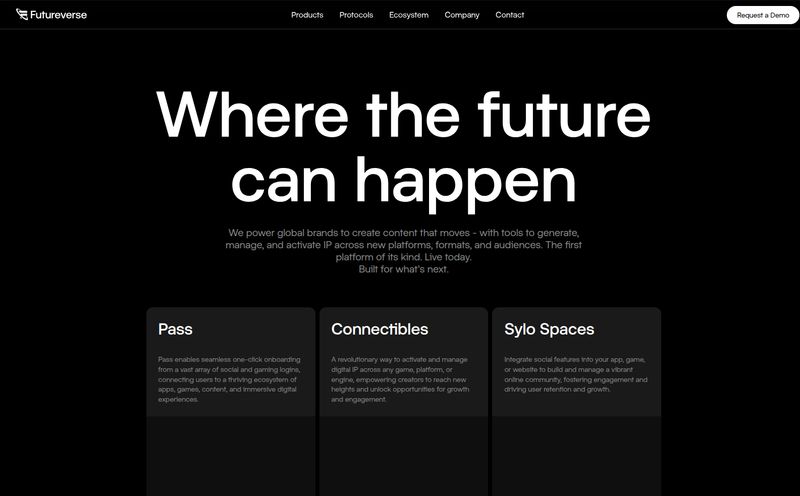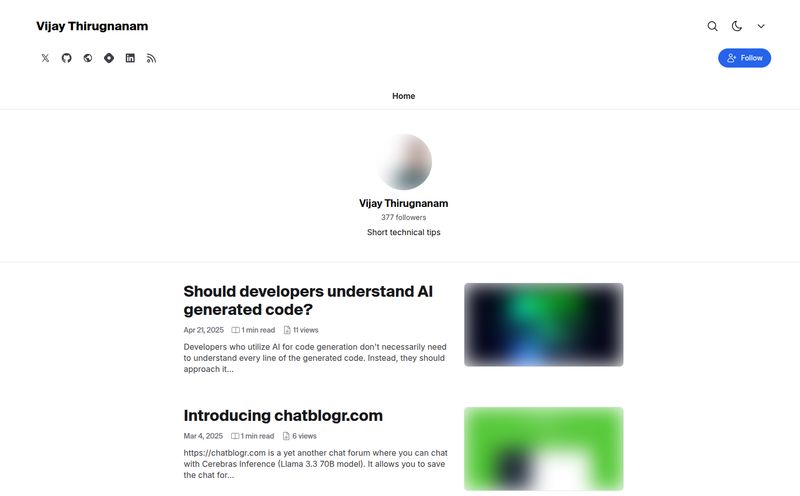I’ve been in the SEO and digital marketing game for a long time. Long enough to remember when building a simple website felt like rocket science, let alone a mobile app. The promises of “build it in minutes!” have been echoing through the halls of tech for decades, from the clunky days of GeoCities to the more polished drag-and-drop builders of today. So, when a tool like Glowbom comes along claiming you can create an app with AI, without coding, just by sketching your idea... well, my inner skeptic raises a well-practiced eyebrow.
But my inner geek, the one that gets excited by shiny new tech, sits up a little straighter. We're living in a wild time for artificial intelligence. Things that were sci-fi a few years back are now popping up in our daily tools. So, is Glowbom just another flashy promise, or is it a genuine step toward democratizing app development? I had to find out.
So, What Exactly is Glowbom?
At its heart, Glowbom is a “draw-to-code” platform. Forget wrestling with divs or trying to remember the right syntax. The core idea is brilliantly simple: you provide a visual concept—a sketch, a wireframe, even a design you whipped up in Canva—and its AI, which they call Glowby Genius, gets to work. It analyzes your design and spits out the actual code for a functional application. It's not just another website builder; it's designed to generate native code for different platforms. Pretty wild, right?

Visit Glowbom
It's like describing a cake to a master baker who then instantly bakes it for you, handing you not just the cake but the entire recipe so you can tweak it later. This is a massive departure from the rigid templates of many no-code tools. It promises a level of creative freedom that has, historically, been reserved for those who speak fluent Swift or Kotlin.
How Does This AI Magic Actually Work?
The process feels almost too simple, which is probably the point. You start by either sketching directly in their interface or uploading a design. This is your blueprint. Then, you tell the AI what you want the app to do. Glowbom’s AI then acts as an interpreter, translating your visual and descriptive inputs into structured code.
Once it’s done its thing, you don’t just get a locked-in, black-box app. You get the source code. You can export it as HTML, SwiftUI for iOS, Kotlin for Android, and even for frameworks like Flutter and Next.js. This is the part that really got my attention. It means you’re not trapped in their ecosystem forever. You can take your code and run with it, hand it off to a developer for more complex features, or even learn from it yourself. It's a bridge, not a walled garden.
The Features That Caught My Eye
Okay, let's get into the nuts and bolts. The multi-platform support is obviously the headliner. The ability to generate code for Native Android (Jetpack Compose), Native iOS (SwiftUI), and Web Apps (React + Typescript) from a single design is a huge time-saver. As an SEO, seeing Next.js support is also a big plus for performance and web visibility.
They’re also not shy about the AI models they're using, listing names like Claude 3.5 Sonnet, Grok, and Llama 3.2. This isn't some vague, proprietary “AI algorithm.” They're plugging into some of the most powerful models out there, which gives me more confidence in the quality of the output. Another neat feature for the more technically inclined is the direct export to Replit, a popular online IDE. It smooths the path from “AI-generated” to “human-edited.”
Of course, I did notice the “Coming Soon” tags on Unity and Apple Vision Pro support. It’s exciting to see them aiming for game development and spatial computing, but it’s also a classic tech industry teaser. I'm optimistic but will hold my applause until those are actually live.
The Good, The Bad, and The AI Credits
What I Genuinely Like About Glowbom
The biggest win here is the sheer accessibility. Think of all the startup founders, small business owners, and creative professionals with brilliant app ideas but zero coding background. Glowbom hands them a key. The speed at which you can go from a simple drawing to a testable prototype is incredible. And the free tier isn't just a gimmick; it’s genuinely useful for getting your feet wet and building something basic. You can actually create and see how it works without pulling out your credit card, which I always appreciate.
A Few Things to Keep in Mind
Now, for a dose of reality. The main point of friction for me is the AI credit system. Even on the paid plans, your AI usage is metered. You get a monthly allowance of credits ($10 on the Creator plan, $20 on the Pro), and I assume you have to buy more if you run out. This is a common model for AI services, but it means you always have a little counter running in the back of your head. It stops you from just experimenting endlessly. I get why they do it—running these big AI models costs a fortune—but it's something to be aware of. Also, as expected, the free plan is limited. If you want to work on multiple projects or export your code freely, you’ll need to upgrade.
Let's Talk Money: Glowbom's Pricing Tiers
The pricing structure is straightforward, which is refreshing. There are three main tiers, and they offer a 40% discount if you pay yearly, a pretty standard and attractive offer.
| Plan | Price | Key Features |
|---|---|---|
| Free | $0 / month | Basic app creation, Brainstorm with Glowby, access to several AI models. |
| Creator | $20 / month | Everything in Free, plus unlimited projects, unlimited exports, Replit export, and $10 in monthly AI credits. |
| Pro | $40 / month | Everything in Creator, plus early feature access, priority support, TestFlight access, and $20 in monthly AI credits. |
In my opinion, the Creator plan at $20 a month is the sweet spot. It removes the major limitations on projects and exports, making it perfect for serial experimenters, freelancers, or anyone serious about building a real app. The Pro plan seems geared towards agencies or power users who need that priority support and want to be on the cutting edge of new features.
Who is Glowbom Actually For?
This is the big question. I see a few perfect fits. First, the non-technical founder. You have the vision, the business plan, but the thought of hiring a dev team makes your wallet cry. Glowbom lets you build a minimum viable product (MVP) yourself. Second, UI/UX designers. Imagine being able to turn your beautiful mockups into functional prototypes for user testing without nagging a developer. Third, students and educators. It’s a fantastic way to learn the fundamentals of app structure and logic without getting bogged down in syntax.
Is it for a team of senior engineers building the next Google Maps? Probably not. It’s an accelerator and an enabler, not a complete replacement for deep, specialized coding knowledge required for highly complex, scalable systems. But that’s okay. It doesn't have to be.
Frequently Asked Questions about Glowbom
- Do I need to know any coding to use Glowbom?
- Nope. That's the whole point. You provide the design and the description, and the AI handles the code generation. Of course, knowing some code will help you customize the output later, but it's not a prerequisite to get started.
- What happens when I use up my AI credits on a paid plan?
- The documentation implies you'd need to purchase more credits to continue using the AI generation features heavily within that month. It's best to use them for the core generation and major revisions rather than tiny tweaks.
- Can I customize the code after exporting it?
- Absolutely. This is one of its strongest features. You get clean, standard code for platforms like SwiftUI and Kotlin. You can open it in your favorite code editor and modify it however you like.
- Is the Free plan good enough to build a real app?
- It's good enough to create a basic app and see the process work. But with limitations on projects and exports, you'll likely want to upgrade to the Creator plan to manage and launch a serious project.
- What platforms can I build for with Glowbom?
- Currently, you can export code for Web Apps (React, Next.js), Native iOS (SwiftUI), Native Android (Kotlin), and cross-platform Flutter. They also have plans for Unity and visionOS in the future.
My Final Verdict on Glowbom
After digging in, my initial skepticism has turned into genuine excitement. Glowbom isn't just another no-code builder; it's a new kind of creative partner. It occupies a fascinating space between an idea on a napkin and a project in a code editor. It won't put brilliant developers out of a job, but it might just create a whole new generation of creators.
It’s a powerful tool that significantly lowers the barrier to entry for app creation. For anyone who's ever said, "I have a great idea for an app, but I can't code," the excuse is starting to wear thin. Tools like Glowbom are changing the game, and I'm here for it.



